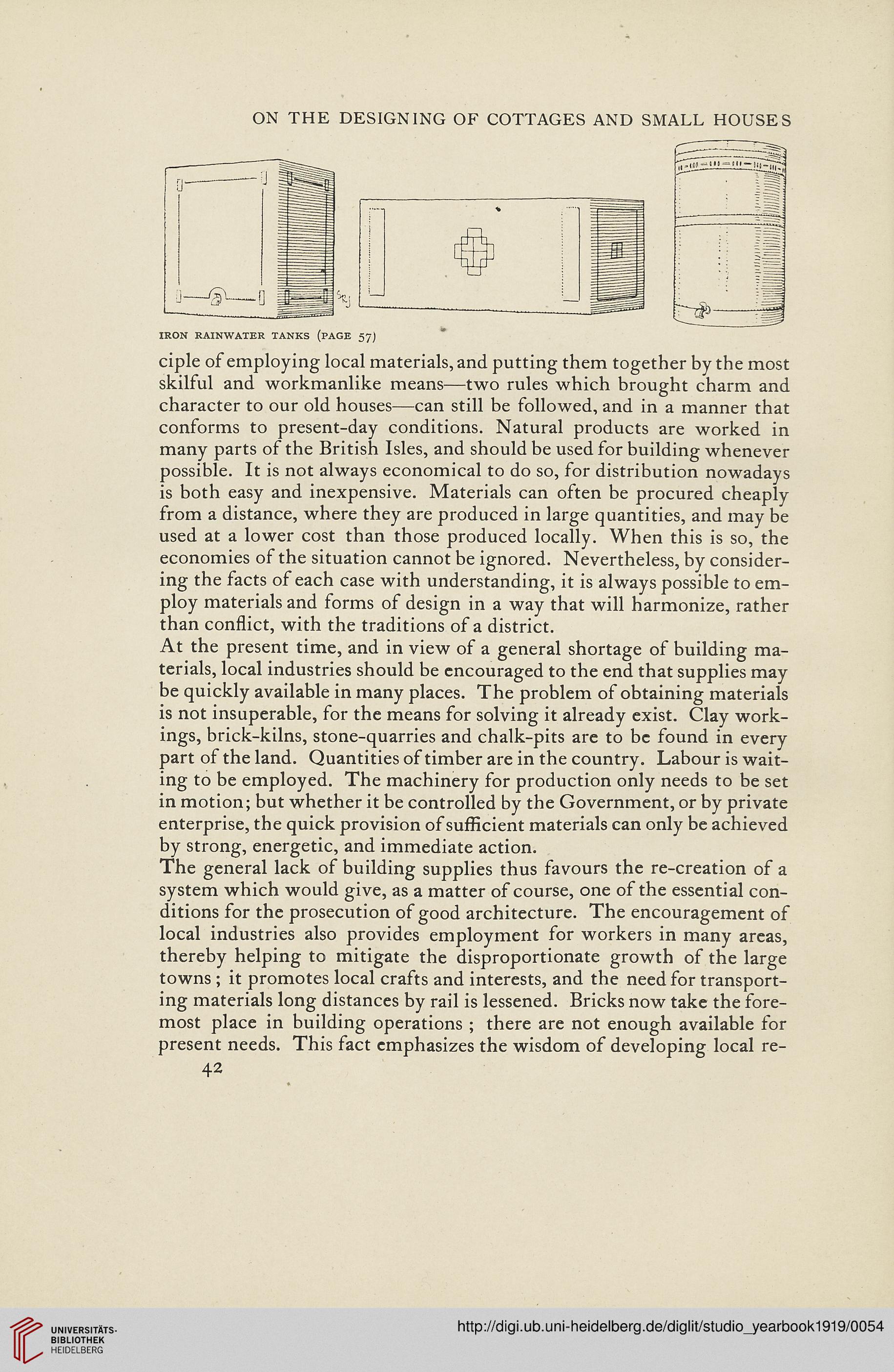ON THE DESIGNING OF COTTAGES AND SMALL HOUSES
IRON RAINWATER TANKS (PAGE 57)
ciple of employing local materials, and putting them together by the most
skilful and workmanlike means—two rules which brought charm and
character to our old houses—can still be followed, and in a manner that
conforms to present-day conditions. Natural products are worked in
many parts of the British Isles, and should be used for building whenever
possible. It is not always economical to do so, for distribution nowadays
is both easy and inexpensive. Materials can often be procured cheaply
from a distance, where they are produced in large quantities, and may be
used at a lower cost than those produced locally. When this is so, the
economies of the situation cannot be ignored. Nevertheless, by consider-
ing the facts of each case with understanding, it is always possible to em-
ploy materials and forms of design in a way that will harmonize, rather
than conflict, with the traditions of a district.
At the present time, and in view of a general shortage of building ma-
terials, local industries should be encouraged to the end that supplies may
be quickly available in many places. The problem of obtaining materials
is not insuperable, for the means for solving it already exist. Clay work-
ings, brick-kilns, stone-quarries and chalk-pits are to be found in every
part of the land. Quantities of timber are in the country. Labour is wait-
ing to be employed. The machinery for production only needs to be set
in motion; but whether it be controlled by the Government, or by private
enterprise, the quick provision of sufficient materials can only be achieved
by strong, energetic, and immediate action.
The general lack of building supplies thus favours the re-creation of a
system which would give, as a matter of course, one of the essential con-
ditions for the prosecution of good architecture. The encouragement of
local industries also provides employment for workers in many areas,
thereby helping to mitigate the disproportionate growth of the large
towns ; it promotes local crafts and interests, and the need for transport-
ing materials long distances by rail is lessened. Bricks now take the fore-
most place in building operations ; there are not enough available for
present needs. This fact emphasizes the wisdom of developing local re-
42
IRON RAINWATER TANKS (PAGE 57)
ciple of employing local materials, and putting them together by the most
skilful and workmanlike means—two rules which brought charm and
character to our old houses—can still be followed, and in a manner that
conforms to present-day conditions. Natural products are worked in
many parts of the British Isles, and should be used for building whenever
possible. It is not always economical to do so, for distribution nowadays
is both easy and inexpensive. Materials can often be procured cheaply
from a distance, where they are produced in large quantities, and may be
used at a lower cost than those produced locally. When this is so, the
economies of the situation cannot be ignored. Nevertheless, by consider-
ing the facts of each case with understanding, it is always possible to em-
ploy materials and forms of design in a way that will harmonize, rather
than conflict, with the traditions of a district.
At the present time, and in view of a general shortage of building ma-
terials, local industries should be encouraged to the end that supplies may
be quickly available in many places. The problem of obtaining materials
is not insuperable, for the means for solving it already exist. Clay work-
ings, brick-kilns, stone-quarries and chalk-pits are to be found in every
part of the land. Quantities of timber are in the country. Labour is wait-
ing to be employed. The machinery for production only needs to be set
in motion; but whether it be controlled by the Government, or by private
enterprise, the quick provision of sufficient materials can only be achieved
by strong, energetic, and immediate action.
The general lack of building supplies thus favours the re-creation of a
system which would give, as a matter of course, one of the essential con-
ditions for the prosecution of good architecture. The encouragement of
local industries also provides employment for workers in many areas,
thereby helping to mitigate the disproportionate growth of the large
towns ; it promotes local crafts and interests, and the need for transport-
ing materials long distances by rail is lessened. Bricks now take the fore-
most place in building operations ; there are not enough available for
present needs. This fact emphasizes the wisdom of developing local re-
42




